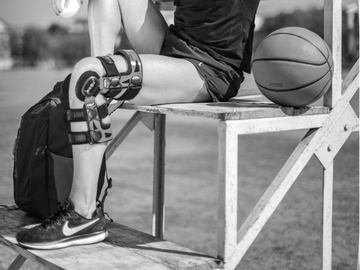Anterior cruciate ligament (ACL) injuries are a common injury among athletes, particularly in sports that involve cutting, pivoting, and jumping movements such as basketball. The ACL is a ligament in the knee that helps to stabilize the joint and prevent excessive forward movement of the tibia relative to the femur.
When someone has an ACL injury, they need to follow a program to make their knee strong and stable again. This can take a long time, depending on how bad the injury is. It usually takes several months to a year to get better. Even after you are better, you can get hurt again, especially if you don't take care of yourself or prepare properly before going back to sports.
In rehab, the patient will work with a physical therapist who guides them through exercises to strengthen and stabilize the knee. The goal is to gradually build up the muscles and increase stability in the knee. The therapist may also teach the patient techniques to help prevent future injuries, such as proper landing and cutting techniques.
The risk of re-injury after an ACL injury can be reduced by several means:
- Following a comprehensive rehabilitation program, after an injury or surgery
- Wearing proper knee braces or supports, which can help to provide extra support and stability to your knees
- Incorporating exercises that target the muscles that help to stabilize the knee, such as the quadriceps and hamstrings.
- Incorporating exercises to improve balance and coordination
- Gradually returning to sports activities
- Avoiding activities or movements that cause pain or discomfort in your knees
It is hard to give an exact percentage for re-injury as it vary greatly depending on many factors such as; severity of the injury, quality of the surgery, the rehabilitation protocol and the way the individual returns to the sport. It is important for patients to follow their rehab program and take it seriously, even if progress feels slow at times.
However, studies have shown that the re-injury rates for ACL reconstruction can be as high as 20-30% within the first 2 years after the surgery. The rate can be even higher for athletes who return to high-demand sports such as basketball. With a good rehabilitation program and taking the proper precautions, it is possible to reduce your risk of re-injury. It is also important to monitor your knee regularly and consult with a physical therapist or sports medicine doctor if you have any concerns.

Citations:
- Arundale, A. J. H., Silvers-Granelli, H. J., & Myklebust, G. (2022). ACL injury prevention: Where have we come from and where are we going? Journal of Orthopaedic Research, 40(1), 43-54. https://doi.org/10.1002/jor.25058
- Hewett, T. E., Myer, G. D., Ford, K. R., Paterno, M. V., & Quatman, C. E. (2016). Mechanisms, prediction, and prevention of ACL injuries: Cut risk with three sharpened and validated tools. Journal of Orthopaedic Research, 34(11), 1843-1855. https://doi.org/10.1002/jor.23414


Add comment
Comments